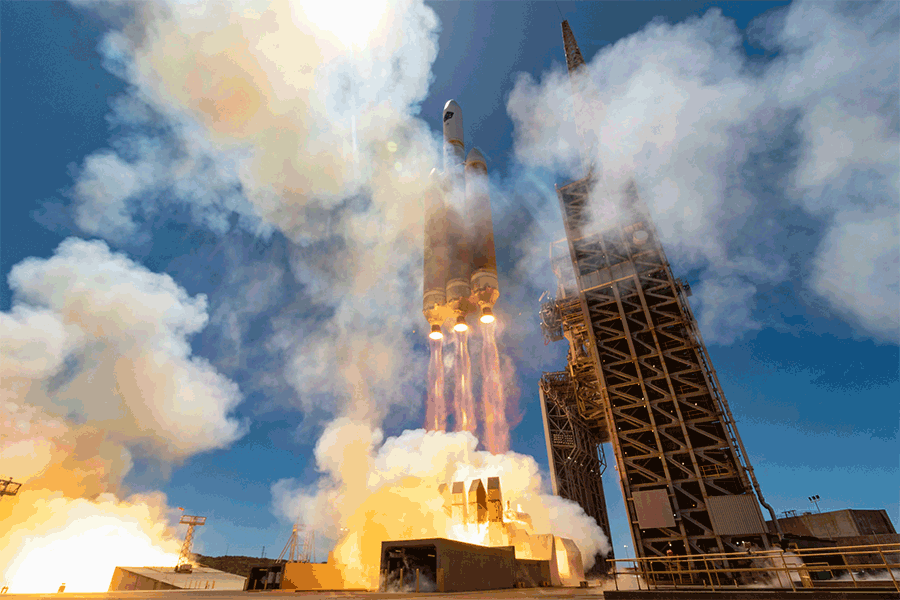

Way back in 1956, William Beller, a Hughes Aircraft engineer and professor at Georgia Tech teamed up with rocket-propellant engineer Erik Bergaust to co-write a book titled “Satellite!” Published a full year before the launch of Sputnik 1 at a time when human exploration of space was just beginning, Beller and Bergaust’s book made a series of stunningly accurate predictions on how satellite technology will impact the lives of future citizens.
Take, for example, their description of how the construction of small satellites designed for Low-Earth Orbit (LEO) would be no more complicated than manufacturing television sets: “They will be built quickly in laboratories,” wrote Beller and Bergaust. “The first small satellites will be used to obtain more accurate measures of the Earth’s geodetic data. This means that we shall be able to make accurate maps and construct better navigational devices for our ships and airplanes.”
As if wielding a telescope that could see 65 years into the future, Beller and Bergaust envisioned a market of highly advanced rockets that would be needed for placing large fleets of small satellites in orbit, and, “complex ground facilities will be required to distribute data to various weather stations, laboratories, fire departments and hospitals.”
They even predicted the adoption of in-flight connectivity: “Tomorrow’s jet air lines will have in-flight television. Programs in color, high-definition, and even 3D will be relayed to the airplane from outer space. The TV short waves will fly out to large and small satellites that will relay the programs to receivers on the other side of the globe.”
Considering Beller and Bergaust’s successful soothsaying, it’s not impossible to imagine the 50-year evolutionary path of satellite and space technology to the year 2071. And, there is some consensus among today’s satellite industry professionals about the technological milestones that satellites will definitely hit during the next few decades.

Bergaust, Eric, & Beller, William. Satellite!. 1956. Hanover House.
Bergaust, Eric, & Beller, William. Satellite!. 1956. Hanover House.
Everyone who was interviewed for this 50-year forecast agreed that the space industry will continue developing high-throughput satellite technology beyond the K-bands. Future satellites will certainly utilize ultra-high frequency bands in V-, Q-, and W-band. While activity from satellites in Geostationary Orbit (GEO) may become much more focused and specialized, LEO satellite systems will be firmly entrenched as front-line communications networks for mobile businesses and remote consumers. Finally, the mission of bridging the digital divide will almost certainly continue past the year 2071, though most expect the number of completely unserved end users to drop below the 1 billion mark by that time.
Predictions vary when the question becomes: What will be the space and satellite industry’s most important change during the next 50 years? This question points to a re-imagining of the “commercial space industry” concept – a shift from a numbers-driven business, to one guided by socioeconomic need and the human instinct to explore.
Tiphaine Louradour, president of International Launch Services (ILS), wishes Hughes continued success for many years to come.
Tiphaine Louradour, president of International Launch Services (ILS), wishes Hughes continued success for many years to come.

Tom Stroup, president of the Satellite Industry Association (SIA), represents an industry in a constant state of change. He believes that we are only limited in our predictions of the future by what we know today — and we know a lot more about space today than we did at the birth of the commercial space industry more than 50 years ago. Looking to the future, Stroup does not want to underestimate the importance of the developments that will occur during the next 10 years.
“In the next decade, artificial intelligence will drive manufacturing, operations and space sustainability in ways impossible to comprehend even today,” says Stroup. “During the next 50 years, Moore’s law and quantum computing will continue to drive more capability and capacity into every aspect of the satellite industry, so that there will be no bounds to communications and information access anywhere on Earth. What we choose to do with that may be more important than the advancement of the technology itself.”
Stroup isn’t the only one who thinks that the societal purpose of satellites will become more important in the future than the specific functionality and capability of new technologies in space. Charity Weeden, who is vice president of space policy for Astroscale – a Japanese start-up that is building and launching satellites to clean up dangerous orbital debris – says that space technology will be driven by the state of our planet and humanity over the course of the next 50 years.
“This industry has followed the needs and trends here on Earth since we became a spacefaring species. Therefore, I feel the downstream effects of climate change and great power competition will dominate the space landscape.”
— Charity Weeden, Vice President of Space Policy, Astroscale


The space environment itself may become more volatile, as space becomes more crowded and nations compete to create new space-based economies.
The space environment itself may become more volatile, as space becomes more crowded and nations compete to create new space-based economies.
“This industry has followed the needs and trends here on Earth since we became a spacefaring species,” says Weeden. “Therefore, I feel the downstream effects of climate change and great power competition will dominate the space landscape. Resource management, more efficient transportation of both information and goods, and multi-orbital, multi-celestial body basic services like telecom and remote sensing for government and private exploration or resource extraction are a few examples.”
While Weeden is optimistic about our future in space, she does believe that the space environment itself may become more volatile, as space gets more crowded and nations compete to create new space-based economies. At the time this is being written, there are more than 52,000 satellites currently in development and planned for launch just within the next decade. This includes massive LEO constellations, large GEO satellites, in-orbit service vehicles, and interplanetary spacecraft. But, this does not include potentially tens of thousands of satellites that are kept secret for national security or business reasons.
“This requires both new behaviors and technologies to stem the effects of a congested and harsh space environment – perhaps even a new international treaty to capture the new rules of the road,” says Weeden. “I also think large-scale efforts to eliminate diseases will include in-orbit science and manufacturing, where the satellite industry will most certainly play a role as a health care partner.”
In order to build new space-based economies and improve the quality of life on Earth, space-faring nations not only need affordable access to space, but also instant availability – to the point where it is just as easy to take your business into space as it is to drive your car onto a local highway.
When Al Tadros landed his first job in the satellite industry more than 30 years ago, space was anything but accessible. “A lot of people don’t remember that we were just coming out of a decades long Cold War,” he says. “A lot of the things we’re doing today, like satellite imagery and telecommunications, were very secretive back then. Access to space was much more exclusive.”
Tadros is now chief growth officer at Redwire – a combination of several acquired companies looking to build a new infrastructure system in space to allow for in-orbit manufacturing and transportation. He previously worked for satellite manufacturer SSL, where he worked with Hughes Network Systems on a variety of new satellites, including most recently, Jupiter 3. “I even applied for a job at Hughes when I got of college,” says Tadros. “They were always doing something exciting and cutting-edge.”
Around the time Tadros was first getting his feet wet in the industry, satellite operator Teledesic came out with a plan in the 1990s to build a commercial broadband satellite internet constellation comprised of 800 satellites. Tadros uses Teledesic as an example of just how far the industry has come just in 30 years. “We all thought Teledesic was crazy,” he said. “Even if you added up all the launches that were happening in the 90s all over the world all at once, you still couldn't get 800 satellites up. Now, we’re putting thousands of satellites into space within a year. SpaceX just completed nine launches in the first quarter of this year. It’s this kind of acceleration that’s going to be crucial to what happens over the next 50 years.”
What will the future space economy look like? Will the space-based economy be interplanetary and include activity around Earth, the Moon, and even Mars? Will this economy be limited to ultra-high-tech industries and government and military organizations?

As space launch is a regular occurrence in 2021, experts expect it will become even more routine in the future. Photos via United Launch Alliance, and Arianespace
As space launch is a regular occurrence in 2021, experts expect it will become even more routine in the future. Photos via United Launch Alliance, and Arianespace
What will the future space economy look like? Will the space-based economy be interplanetary and include activity around Earth, the Moon, and even Mars? Will this economy be limited to ultra-high-tech industries and government and military organizations?


A rendering of a Nanoracks StarLab Space Farming Center. Photo: Nanoracks/ Mack Crawford
A rendering of a Nanoracks StarLab Space Farming Center. Photo: Nanoracks/ Mack Crawford
Morgan Stanley equity analyst Adam Jonas predicts that investments in space during the next few decades will create trillions of dollars of new economic activity. In the short term, the foundation of the space economy will consist of business in aerospace, defense, IT hardware, and telecom sectors, generating more than $1 trillion in new revenue by 2040. The current commercial space industry generates $350 billion in total global revenue. But, if companies like SpaceX, Blue Origin, and Rocket Lab continue to make space more accessible, Jonas believes a larger share of the public sector will move to space.
“Access to space offers some tantalizing possibilities for the enterprise markets. Packages today delivered by airplane or truck could be delivered more quickly by rocket,” says Jonas. “Perhaps private space travel could become commercially available. Mining equipment could be sent to asteroids to extract minerals—all possible, theoretically, with the recent breakthroughs in rocketry … Initiatives by large public and private firms suggest that space is an area where we will see significant development during the next few decades.”
Beyond just launch services from Earth to orbit, Tadros believes that in-orbit servicing, life-extension, space debris clean-up, and in-space transportation will be the cornerstones of the future space economy in the next 50 years.
“In-space transportation, whether it's electric or nuclear-electric propulsion, I think, will open up the Wild West,” says Tadros. “It will have the same impact on society as the railroads had in the United States. It will help develop the frontier. A lot of what we consider to be the more sci-fi developments right now, like building in-space habitats, are much closer to us now than how close they felt to Americans during the days of the Apollo rockets. The Moon really does feel right next door. Mars is not that far off. Going there won’t feel any more special than taking an airplane to New York City.”
Pradeep Kaul & Pradman Kaul
Pradeep Kaul & Pradman Kaul

To learn more about Hughes, please visit www.Hughes.com.


